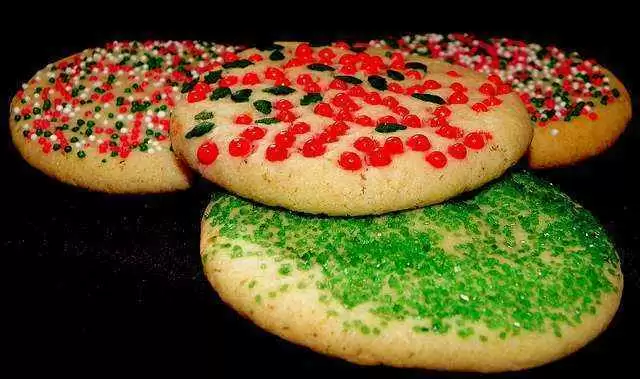
Celiac.com 08/01/2020 - Discover how fun, easy, and rewarding cookie-baking can be the gluten-free way! Read through the cookie-baking FUNdamentals to understand the secrets in making award-winning gluten-free cookies. Use these tips to bake the Lime-Sugar Cookies.
Let’s explore the eight essential cookie-baking FUNdamentals: quality ingredients, proper equipment, accurate measurements, proper techniques, accurate oven temperature, correct baking time and proper cooling and storage. Applying these basics will make a difference in the final results…your cookies can go from average to “wow.”
Quality Ingredients
Celiac.com Sponsor (A12):
The difference is in the ingredients. You can’t expect to make championship cookies using inferior ingredients. Start with a well-balanced gluten-free flour mix that contains healthy flours such as brown rice flour, navy bean flour, sorghum flour or almond meal (if not allergic); then add other quality ingredients.
Butter (especially unsalted) is the most popular of the fats used for cookies by bakers. There is no substitute for the richness and flavor of butter, but you can replace butter with stick margarine. Whipped, tub, soft, liquid or reduced-fat margarines are unacceptable for baking because they contain air and water and will produce flat, tough, under-browned cookies.
Using pure extracts (not imitation); fresh, aromatic spices, quality chocolate (the best you can afford), true white chocolate (cocoa butter is 2nd ingredient), and fresh nuts can make the difference between an average cookie and an outstanding cookie. For best results: Use the exact same ingredients every time to get consistent results. Find brands you like, and stick with them.
Proper Equipment
Proper equipment makes the whole baking process more efficient and contributes to successful results. Two important equipment items are quality cookie sheets and a free-standing oven thermometer.
The best overall cookie sheets are light-colored, dull-finished, heavy-gauge aluminum with one or two low sides. Heat circulates efficiently during the baking process and cookies bake and brown more evenly. For best results: Bake only one sheet of cookies at a time on the middle rack. If possible, have 2-3 identical cookie sheets on hand; while one is baking, another is cooling and the third one is ready to be placed in the oven. Using identical cookie sheets guarantees similar baking results every time.
A free-standing oven thermometer is essential to accurate baking. Ovens may vary as much as 50 degrees; keeping a thermometer in your oven all the time helps you to adjust the heat for proper baking. For best results: Clip an oven thermometer on the middle rack in the center of the oven and use it to judge the heat, not the dial.
Here are a few other useful items:
- A wire mesh strainer (6-inch diameter) removes lumps, aerates the flour and incorporates all the dry ingredients in a homogenous manner.
- A cookie scoop with spring-release mechanism makes uniform-size drop cookies so cookies bake evenly and at the same time.
- A heavy-duty, free-standing electric mixer with a paddle attachment is essential in all types of gluten-free baking.
- Parchment paper helps cookies retain their shape, bake evenly and prevent over-browning.
- Non-stick aluminum foil ensures easy removal of bars and ease of cutting.
- Stainless steel or non-stick wire cooling racks with small grids and “feet” ensures proper cooling.
Accurate Measurements
Baking requires precise measurements for successful results. Measuring ingredients accurately with the appropriate measuring tools and techniques means you’ll get consistent results every time you make a cookie recipe. Never use dry-ingredient cups to measure liquid ingredients or liquid-ingredient cups to measure dry ingredients. They can’t be used for the other without sacrificing accuracy. For best results: Use standard, stainless steel dry-ingredient measuring cups and spoons with straight rims – the latter allow you to sweep a flat edge across the top and measure ingredients accurately. Use a glass measuring cup with a spout to measure liquids. Read measure at eye level.
Measuring Techniques
The primary reason cookies don’t turn out quite right is inaccurate or inconsistent measurements, especially with the flour. Too much flour can cause dry, tough cookies and too little can cause flat, pancake-like cookies. For best results: Spoon flour into measuring cup (as opposed to dipping the cup into the ingredient) before leveling it with a straight edge, like a table knife. You’ll get a more consistent result this way. Dipping the cup or shaking the cup while spooning in flour compacts the flour too much which results in too much flour being used. This applies to all dry ingredients except brown sugar which needs to be packed.
Mixing Techniques
Mixing methods, among other factors, influence the texture (light and tender, soft and chewy, crisp or dense) of the cookie. Using an electric mixer and beating (creaming the butter and sugar) creates a light and tender cookie. Using a spoon and stirring ingredients together creates a dense and chewy cookie, such as brownies. For best results: Look for recipes that give you specific mixing directions and follow them.
Accurate Oven Temperatures
Baking cookies at the wrong temperature can cause unpredictable and undesirable results. It takes 15-20 minutes to preheat an oven to the correct temperature. Place an oven thermometer on the middle rack in the center of the oven and use it to judge the heat, not the dial. For best results: Check temperature and make adjustments before placing cookies in the oven.
Baking Times
Consider the baking time given in a recipe as a guide to start checking for doneness. All ovens bake differently. Note the baking time required in your oven and record it on the recipe for future use. For best results: Bake cookies one sheet at a time on the middle rack. Be sure cookie sheet is cool before placing dough on it or the cookies will spread excessively and brown too much on the edges.
Proper Cooling and Storage
Some gluten-free cookies need a longer time to set before transferring to a wire rack to cool completely. Follow the recipe’s directions. Be sure cookies are completely cool before placing them in storage containers or cookies will turn soggy. For best results: Store the same kind of cookies together (soft with soft, crisp with crisp, flavor with flavor) to prevent changes in texture and flavor. If you mix crisp cookies with soft cookies, the crisp ones will get soft and the flavors often mix.
Get ready to bake…. It’s gluten-free cookie time!
Now head for the kitchen, preheat the oven, and read the entire Lime Sugar Cookie recipe to ensure all necessary ingredients are available and if any advance procedure needs to be done. With a little effort, you’ll receive big rewards and lots of cookie kudos from family and friends. May your cookie jar always be full. Enjoy my Lime Sugar Cookies.
Gluten-Free Lime Sugar Cookies Recipe
This cookie was a celebrity among taste testers and voted as one of the best! Double the recipe for double the pleasure!
Ingredients:
- 1½ cups gluten-free flour mix
- 1 ¼ teaspoons xanthan gum
- 1 teaspoon cream of tartar (find in baking aisle)
- ½ teaspoon baking soda
- ¼ teaspoon salt
- ½ cup (1 stick) unsalted butter
- 1 cup lime-scented sugar (see recipe below)
- ¼ teaspoon pure lime oil
- 1 large egg
Directions:
- Preheat oven to 350 degrees F. Line cookie sheets with parchment paper.
- Sift flour, xanthan, gum, cream of tartar, baking soda and salt in bowl; stir. Set aside.
- Beat butter, lime-scented sugar, and lime oil in large mixer bowl on medium speed until creamy, about 4 minutes. Beat in egg. Gradually beat in flour mixture.
- Measure dough in 1 ½ tablespoon portions (cookie scoop works great); shape into balls. Place balls 3 inches apart on prepared sheet. With hand, slightly flatten dough to ½- inch thickness.
- Bake 13 to 14 minutes or until edges are lightly browned. Cool 3 minutes on cookie sheet then transfer to wire rack to cool completely. Sprinkle lime-scented sugar over cookies, if desired.
- Store in airtight container up to 2 days or freeze up to 2 months.
Makes 1 ½ dozen (3-inch) cookies
To make lime-scented sugar: Place 1 ¼ cups granulated sugar and 2-3 tablespoons freshly grated lime zest (about 3 large limes) in bowl of food processor; process until blended, about 15 seconds. Refrigerate leftovers in an airtight container.
Cookie Tips: Use more freshly grated lime zest for a stronger lime flavor. If lime is not a favorite flavor, try orange or lemon for an equally awesome cookie.









Recommended Comments
There are no comments to display.
Create an account or sign in to comment
You need to be a member in order to leave a comment
Create an account
Sign up for a new account in our community. It's easy!
Register a new accountSign in
Already have an account? Sign in here.
Sign In Now